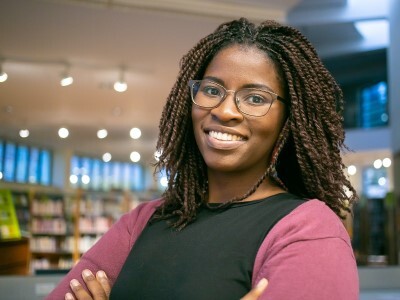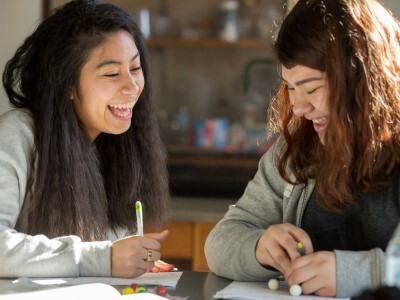Setting a Strong Personalized Learning Vision in Henry County
Topics

Next generation learning is all about everyone in the system—from students through teachers to policymakers—taking charge of their own learning, development, and work. That doesn’t happen by forcing change through mandates and compliance. It happens by creating the environment and the equity of opportunity for everyone in the system to do their best possible work.
Practitioner's Guide to Next Gen Learning
A universal vision for personalized learning in this metro Atlanta school district enables schools to create their own pathway to student-centered learning.
In today’s Friday Focus: Practitioner’s Guide to Next Gen Learning, you will:
Explore personalized learning efforts at Henry County School District, Georgia
Learn about the district’s universal vision that enables school-level autonomy
See personalized learning highlights in two schools
Collaborative learning. Enabling choice and voice. Competency-based progression. One-size-fits-one. More and more educators are embracing these components of personalized learning. As the number of districts and schools adopting personalized learning increases, our tent is getting bigger and we’re discovering new ways to share lessons learned from our collective efforts. By seeking out, highlighting, and connecting educators like you who are invested in impactful work, we strengthen our individual missions as well as the greater mission of personalized learning.
The NGLC Regional Funds partners had one of those moments recently when visiting Henry County Schools in Georgia. Carmen Williams, the director of professional learning at Thompson School District, a Breakthrough Schools: Colorado grantee, participated in the visit. She noted the value of learning from this growing tent, saying, “We don’t have to start from scratch; we can share resources from everyone so we are empowered to grow.”
Henry County Schools: Personalizing a District Vision
Henry County Schools (HCS) is a member of the Gates Foundation’s Next Gen Systems Initiative (NGSI), a group of six districts implementing a systemic vision for personalized learning by supporting cohorts of schools through a redesign and launch process.
HCS has a strong, tight vision for personalized learning, and a loose approach to school-level adoption. This balance, explained in an informative presentation deck created by the district, is part of their secret sauce.
Special Projects Coordinator for the district, Karen Perry, explained that HCS approached the school redesign through a process of commitments: to equity and greater transparency, to collecting stakeholder input in the planning and implementation process, and to allowing significant school-level flexibility while holding schools to a high bar of expectation. The district is dedicated to ensuring that schools foster student agency over learning and focusing on the skills needed for lifelong learning in order to be successful in college, career, and life. HCS students are expected to be equipped to make substantive decisions about their learning, including pace and pathways, as well as demonstration of their mastery.
These commitments are reflected in the five personalized learning tenets created to support Henry County School’s overall mission.
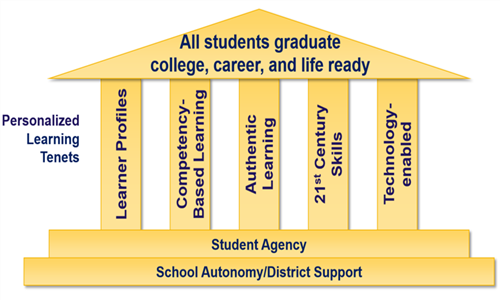
Source: Henry County Schools
The five tenets are:
Learner Profiles: Learner Profiles reflect students’ school performance, strengths, and interests. Students, with their families and HCS staff, chart their unique learning paths through goal setting and reflection.
Competency-Based Learning: Clearly identified learning targets allow students to demonstrate mastery of competencies using multiple forms of evidence. Time and place are flexible while learning is constant.
Authentic Learning: Students learn through real-world projects, problem solving, and service learning inside and outside of the classroom, and present evidence of their learning to authentic audiences such as parents, businesses, and community members.
21st Century Skills: Learning experiences are designed to intentionally teach and hone key overarching skills and dispositions needed for college, career, and life success in the 21st century.
Technology-enabled: Students use technology to learn and demonstrate what they know. Technology enables, but does not drive, personalized learning experiences.
Visiting guests from NGSI and NGLC Regional Funds were struck by the level of buy-in and ownership around the district’s vision. District officials invested in outreach resources in order to engage community members in the shift to personalized learning. They used resources similar to this video to facilitate conversations with educators and support staff new to this approach:
“It was very impressive how everyone was able to talk about the district’s vision. Even the school committee members who joined us for dinner could speak to it,” commented Ramona Treviño, senior director, district and school design at the Center for Collaborative Education.
Another ingredient to HCS’s growing success is the long on-ramp afforded each local school team to access funds and support for personalized learning. Every team was invited into the opportunity and asked: What is their school’s approach and plan for personalized learning? Why is it important? Why do they think it would help realize the overarching vision? School teams chose when, how, and why to bring the district vision to life for their students and within their own professional learning communities. Affording this flexibility created a natural alignment between student and adult cultural norms to support voice and choice, ownership and agency, and flexible timelines needed to access new understandings and related shifts in operations.
Through school visits to Ola Elementary and Luella Middle School, visitors were able to see the district vision come to life in different ways.
Ola Elementary School
Ola Elementary is in its first year of implementing personalized learning. The school is using competency-based learning to guide its overall strategy for learning, complemented by small group learning, station rotation, regular meetings between students and advisors, and blended learning.
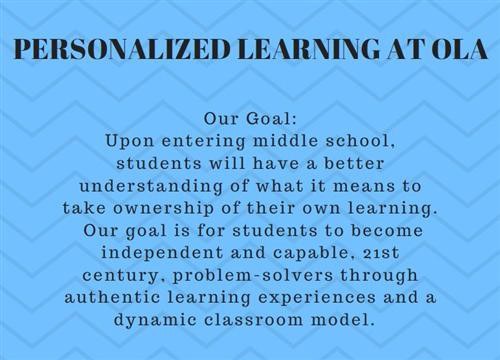
Source: Ola Elementary School
Dennis Russo, personalized learning coordinator at Pinellas County Schools in Florida, noted that it was unique to see first, second, and third graders work independently and collaboratively with each other while the classroom teacher focused on small group instruction. That “is not something that just happens,” said Dennis. He added that it is “all possible because of the culture and expectations that the teachers set with the students.”
Ola Elementary’s culture purposefully supports the goal to have students take ownership over their own learning. This kind of student agency is key to the success of the personalized learning efforts at the school.
Luella Middle School
The educators and students at Luella Middle School started implementing personalized learning two years ago. The goal of the school is to create lifelong learners who manage their own learning through voice and choice to accomplish measurable goals in a supportive environment, utilizing 21st century skills.
You can see evidence at Luella of the work they’ve done as a faculty to establish common and specific understandings about personalized learning. Here’s an example:
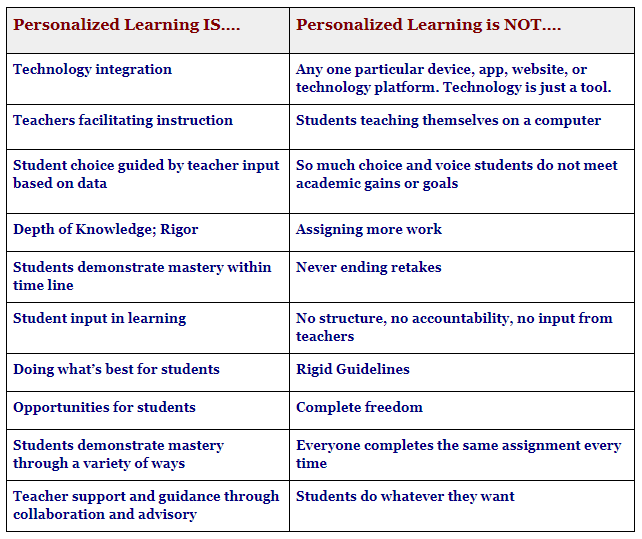
Source: Luella Middle School
The school’s students are focused on developing skills in goal setting, collaboration, taking intellectual risks, solving problems creatively, critical thinking, and communication. By creating an intentional culture of personalization through project-based learning, educators at Luella Middle School are helping students develop these skills.
One of the efforts at Luella Middle School that stood out to visitors was “What I Need Days,” also known as WIN. Once a week all students are able to make choices based on a subject area in which they need additional support and express their preferred instructional methods for that assistance. While sometimes advisors and teachers help students make good decisions, students are encouraged to make their own choices. The goal of WIN days is to not only personalize the academic support students receive but also to enable students to identify, express, and understand their needs better. In this way, they experience a shared responsibility for their growth. They learn how to make choices that will advance their learning.
The efforts of both schools are making a difference. Student regularly demonstrate their progress through work samples.
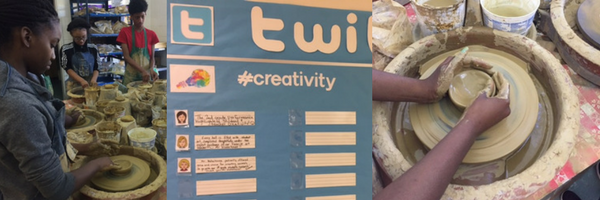
Student work is managed individually, collectively, and as is often the case in rich learning environments—artfully, decorating the walls, halls, and shared learning spaces. Jeri Crispe, director of secondary education at Thompson School District in Colorado, noted that it was “fun to see the students’ enthusiasm around personalized learning and their ability to explain what they are learning and what it means to them.”
The team and I would like to extend special thanks to Kavitha Thimmaiah of Communications Strategy Group for her help in putting together this edition.


